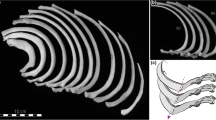Abstract
Biological sex estimation is one of the main parameters required in the construction of a biological profile of an unknown deceased person. In corpses in an advanced state of decomposition, skeletonized or severely mutilated, bone analysis may provide the only way to access biological sex. Although the hip bones are the most dimorphic and useful bones for sex estimation, they are often badly preserved and/or fragmented or may not even be present in some cases. For that reason, it is necessary to develop sex estimation methods based on bones less dimorphic. In this study, 13 dimensions of the second cervical vertebra were measured in order to quantify sex-related variation and to generate a simple predictive model based on logistic regression analysis. For logistic regression fitting, 190 individuals from the Coimbra Identified Skeletal Collection were used as a training sample. The resulting model was also evaluated in an independent test sample composed of 47 individuals from the Identified Skeletal Collection of the 21st Century (University of Coimbra). The developed logistic regression model correctly estimated known sex in 86.7 to 89.7 % of the cases. The second cervical vertebra demonstrated to be a useful alternative for sex estimation when other skeletal elements are not available or suitable for analysis. This method seems promising but more reliability studies are required for a more robust validation.



Similar content being viewed by others
References
Bruzek J, Murail P (2006) Methodology and reliability of sex diagnosis from the skeleton. In: Schmitt A, Cunha E, Pinheiro J (eds) Forensic anthropology and medicine: Complementary sciences from recovery to cause of death. Humana Inc, New Jersey, pp 225–242
Gapert R, Black S, Last J (2009) Sex determination from the occipital condyle: discriminant function analysis in an eighteenth and nineteenth century British sample. Am J Phys Anthropol 138:384–394
Marlow J, Pastor F (2011) Sex determination using the second cervical vertebra—a test of the method. J Forensic Sci 56(1):165–169
Rissech C, López-Costas O, Turbón D (2013) Humeral development from neonatal period to skeletal maturity application in age and sex estimation. Int J Legal Med 127(1):201–212
Masotti S, Succi-Leonelli E, Gualdi-Russo E (2013) Cremated human remains: is measurement of the lateral angle of the meatus acusticus a reliable method of sex determination? Int J Legal Med 127(5):1039–1044
Cox M, Mays S (2000) Human osteology: in archaeology and forensic science. Greenwich Medical Media Ltd, London
Cowal LS, Pastor RF (2008) Dimension variation in the proximal ulna: evaluation of a metric method for sex assessment. Am J Phys Anthropol 135:469–478
Ferreira MT (2012) Para lá da morte: estudo tafonómico da decomposição cadavérica e da degradação óssea e implicações na estimativa do intervalo pós-morte. Universidade de Coimbra. Dissertation
Wescott DJ (2000) Sex variation in the second cervical vertebra. J Forensic Sci 45(2):462–466
Medina SC (2011) Dimorfismo sexual en columna vertebral. Universidad de Granada, Dissertation
Bethard JD, Seet BL (2013) Sex determination from the second cervical vertebra: a test of Wescott method on a modern American sample. J Forensic Sci 58(1):101–103
Cunha E, Wasterlain S (2007) The Coimbra identified osteological collections. In: Grupe G, Peters J (eds) Skeletal series and their socio-economic context. Marie Leidorf, GmbH, Rahden/Westf, Germany, pp 23–33
Ulijaszek SJ, Kerr DA (1999) Anthropometric measurement error and the assessment of nutritional status. Br J Nutr 82:165–177
Case DT, Ross AH (2007) Sex determination from hand and foot bone lengths. J Forensic Sci 52:264–270
Barrier ILO, L’Abblé EN (2008) Sex determination from the radius and ulna in a modern South African sample. Forensic Sci Int 179:85.e1–7
Charisi D, Eliopolus C, Vanna V, Koilias CG, Manolis SK (2011) Sexual dimorphism of the arm bones in a modern Greek population. J Forensic Sci 56:10–18
Steyn M, Íscan MY (1997) Sex determination from the femur and tibia in South African whites. Forensic Sci Int 90:111–119
Macaluso PJ, Lucena J (2014) Estimation of sex from sternal dimensions derived from chest plate radiographs in contemporary Spaniards. Int J Legal Med 128:389–395
Author information
Authors and Affiliations
Corresponding author
Rights and permissions
About this article
Cite this article
Gama, I., Navega, D. & Cunha, E. Sex estimation using the second cervical vertebra: a morphometric analysis in a documented Portuguese skeletal sample. Int J Legal Med 129, 365–372 (2015). https://doi.org/10.1007/s00414-014-1083-0
Received:
Accepted:
Published:
Issue Date:
DOI: https://doi.org/10.1007/s00414-014-1083-0




